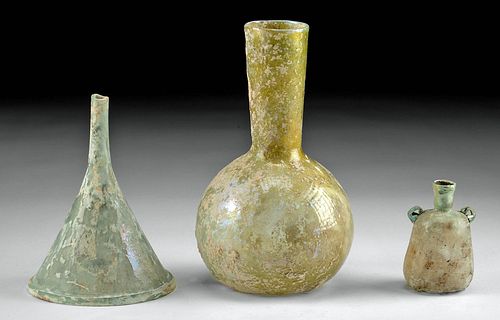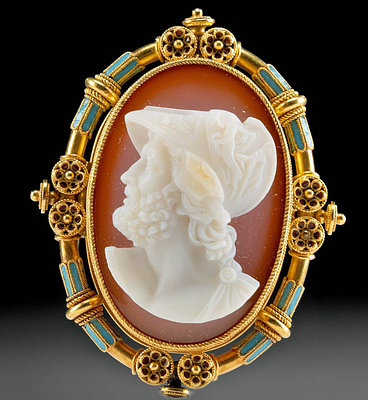Roman Glass - 2 Vessels + 1 Funnel
Lot 80
About Seller
Artemis Fine Arts
686 S Taylor Ave, Ste 106
Louisville, CO 80027
United States
Selling antiquities, ancient and ethnographic art online since 1993, Artemis Gallery specializes in Classical Antiquities (Egyptian, Greek, Roman, Near Eastern), Asian, Pre-Columbian, African / Tribal / Oceanographic art. Our extensive inventory includes pottery, stone, metal, wood, glass and textil...Read more
Categories
Estimate:
$600 - $900
Absentee vs Live bid
Two ways to bid:
- Leave a max absentee bid and the platform will bid on your behalf up to your maximum bid during the live auction.
- Bid live during the auction and your bids will be submitted real-time to the auctioneer.
Bid Increments
| Price | Bid Increment |
|---|---|
| $0 | $25 |
| $300 | $50 |
| $1,000 | $100 |
| $2,000 | $250 |
| $5,000 | $500 |
| $10,000 | $1,000 |
| $20,000 | $2,500 |
| $50,000 | $5,000 |
| $100,000 | $10,000 |
| $200,000 | $20,000 |
About Auction
By Artemis Fine Arts
Dec 9, 2021
Set Reminder
2021-12-09 12:00:00
2021-12-09 12:00:00
America/New_York
Bidsquare
Bidsquare : All That Glitters | Ancient & Ethnographic
https://www.bidsquare.com/auctions/artemis-gallery/all-that-glitters-ancient-ethnographic-8000
Join us for a very special holiday auction featuring jewelry, glass, icons, coins, and so much more. Think silver, gold, and all things shiny. Perfect for holiday gift giving or for self-gifting. Artemis Fine Arts info@artemisgallery.com
Join us for a very special holiday auction featuring jewelry, glass, icons, coins, and so much more. Think silver, gold, and all things shiny. Perfect for holiday gift giving or for self-gifting. Artemis Fine Arts info@artemisgallery.com
- Lot Description
Roman, Imperial Period, ca. 1st to 3rd century CE. A wonderful collection of 2 glass vessels and 1 funnel known as an infundibulum. Formed from translucent green glass, the largest presents a globular body and an elongated neck that gently flares out to a circular rim, all sitting upon a concave base. Alternatively, the remaining vessel and funnel are both made from a translucent, light blue glass. The petite vessel displays a broad base with walls that gently taper to a flat shoulder, a narrow neck, and a flared rim. Twin handles formed from applied trailing adorn the shoulder edge, while a series of risen, horizontal lines embellish the body, forming a spiral on the base. Last, the funnel showcases a conical form with a slender, tubular neck, a wide mouth, and a folded rim. Note the gorgeous rainbow-hued iridescence that nicely complements the forms of all 3 ancient examples! Size of largest: 5" Diameter x 8.3" H (12.7 cm x 21.1 cm)
Provenance: ex-Davis collection, Houston, Texas, acquired before 2013 from various auction houses in London and New York; smallest is ex-Beverly Hills, California, USA collection
All items legal to buy/sell under U.S. Statute covering cultural patrimony Code 2600, CHAPTER 14, and are guaranteed to be as described or your money back.
A Certificate of Authenticity will accompany all winning bids.
PLEASE NOTE: Due to recent increases of shipments being seized by Australian & German customs (even for items with pre-UNESCO provenance), we will no longer ship most antiquities and ancient Chinese art to Australia & Germany. For categories of items that are acceptable to ship to Australia or Germany, please contact us directly or work with your local customs brokerage firm.
Display stands not described as included/custom in the item description are for photography purposes only and will not be included with the item upon shipping.
#139114Losses to bottom rim of funnel and small area on side of largest vessel. Smallest vessel is intact. Otherwise, all 3 are excellent with nice weathering film and beautiful iridescence. Pontil mark to base of smallest vessel. A pontil scar or mark indicates that a vessel was free-blown, while the absence of such a mark suggests that the work was either mold-blown or that the mark was intentionally smoothed away or wore away over time.Condition
- Shipping Info
-
All shipping is handled in-house for your convenience. Your invoice from Artemis Gallery will include shipping calculation instructions. If in doubt, please inquire BEFORE bidding for estimated shipping costs for individual items.
-
- Buyer's Premium



 EUR
EUR CAD
CAD AUD
AUD GBP
GBP MXN
MXN HKD
HKD CNY
CNY MYR
MYR SEK
SEK SGD
SGD CHF
CHF THB
THB













